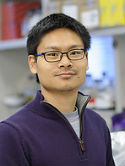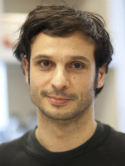Homologous Recombination DNA Repair Genes Play a Critical Role in Reprogramming to a Pluripotent State Journal Article
| Authors: | González, F.; Georgieva, D.; Vanoli, F.; Shi, Z. D.; Stadtfeld, M.; Ludwig, T.; Jasin, M.; Huangfu, D. |
| Article Title: | Homologous Recombination DNA Repair Genes Play a Critical Role in Reprogramming to a Pluripotent State |
| Abstract: | Induced pluripotent stem cells (iPSCs) hold great promise for personalized regenerative medicine. However, recent studies show that iPSC lines carry genetic abnormalities, suggesting that reprogramming may be mutagenic. Here, we show that the ectopic expression of reprogramming factors increases the level of phosphorylated histone H2AX, one of the earliest cellular responses to DNA double-strand breaks (DSBs). Additional mechanistic studies uncover a direct role of the homologous recombination (HR) pathway, a pathway essential for error-free repair of DNA DSBs, in reprogramming. This role is independent of the use of integrative or nonintegrative methods in introducing reprogramming factors, despite the latter being considered a safer approach that circumvents genetic modifications. Finally, deletion of the tumor suppressor p53 rescues the reprogramming phenotype in HR-deficient cells primarily through the restoration of reprogramming-dependent defects in cell proliferation and apoptosis. These mechanistic insights have important implications for the design of safer approaches to creating iPSCs. Induced pluripotent stem cells (iPSCs) hold great promise for personalized regenerative medicine. Here, Huangfu, Jasin, and colleagues show that the ectopic expression of reprogramming factors increases the level of phosphorylated histone H2AX, one of the earliest cellular responses to DNA double-strand breaks (DSBs). Additional mechanistic studies uncover a direct role of the homologous recombination pathway, a pathway essential for the error-free repair of DNA DSBs, in reprogramming. These findings have important implications for creating safer iPSCs for therapeutic use. © 2013 The Authors. |
| Keywords: | controlled study; protein expression; protein phosphorylation; gene deletion; nonhuman; cell proliferation; animal cell; mouse; phenotype; animals; mice; gene; homologous recombination; apoptosis; gene expression; cell line; cell differentiation; tumor suppressor gene; dna modification; dna breaks, double-stranded; double stranded dna break; pluripotent stem cell; histone h2ax; histones; nuclear reprogramming; induced pluripotent stem cells; genes, p53; p53 gene; dna repair gene; recombination repair |
| Journal Title: | Cell Reports |
| Volume: | 3 |
| Issue: | 3 |
| ISSN: | 2211-1247 |
| Publisher: | Cell Press |
| Date Published: | 2013-03-28 |
| Start Page: | 651 |
| End Page: | 660 |
| Language: | English |
| PROVIDER: | scopus |
| PUBMED: | 23478019 |
| DOI: | 10.1016/j.celrep.2013.02.005 |
| PMCID: | PMC4315363 |
| DOI/URL: | |
| Notes: | --- - "Export Date: 1 May 2013" - ":doi 10.1016/j.celrep.2013.02.005" - "Source: Scopus" |
Altmetric
Citation Impact
BMJ Impact Analytics
Related MSK Work









